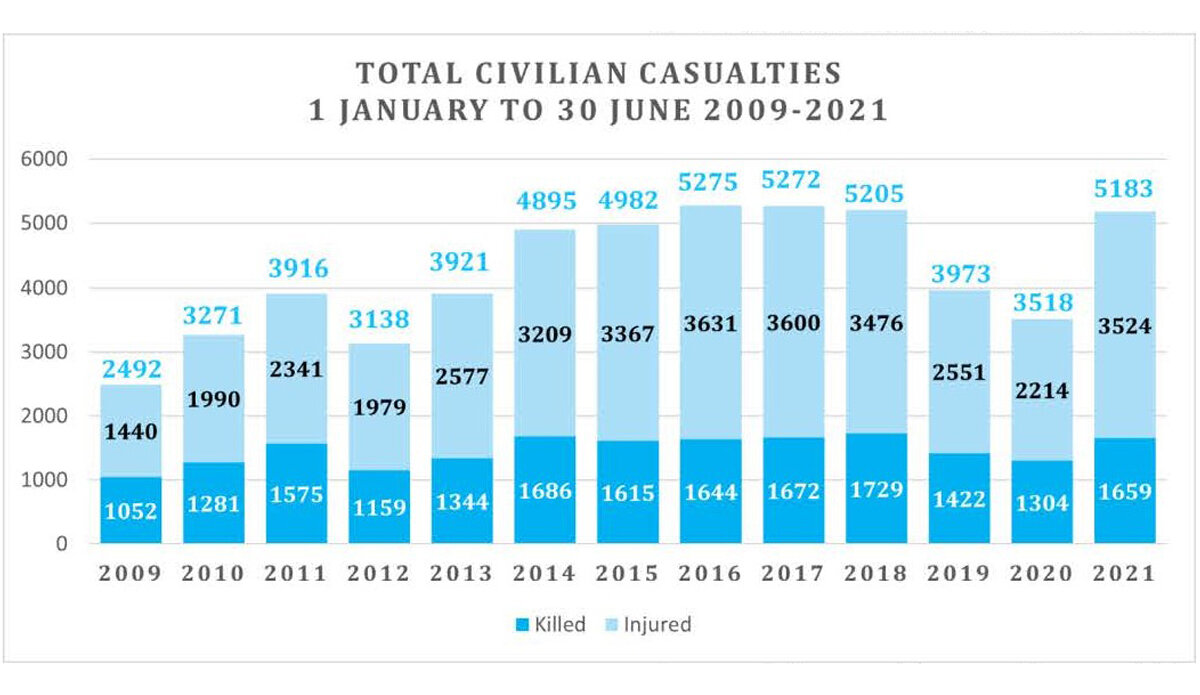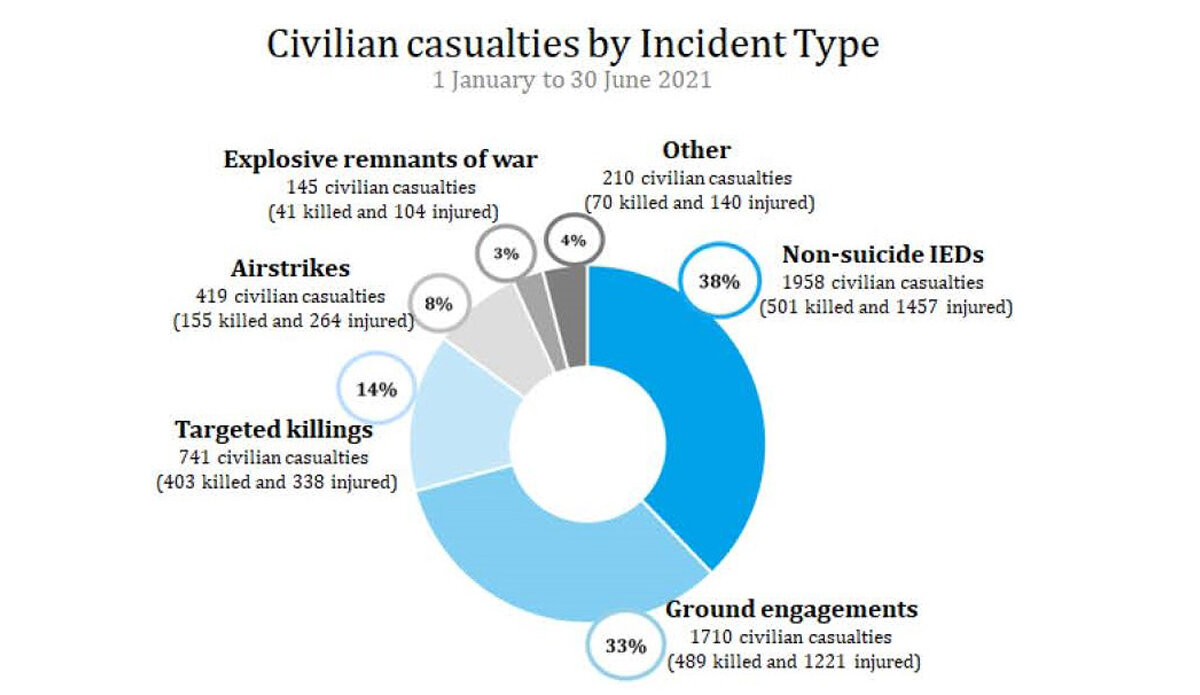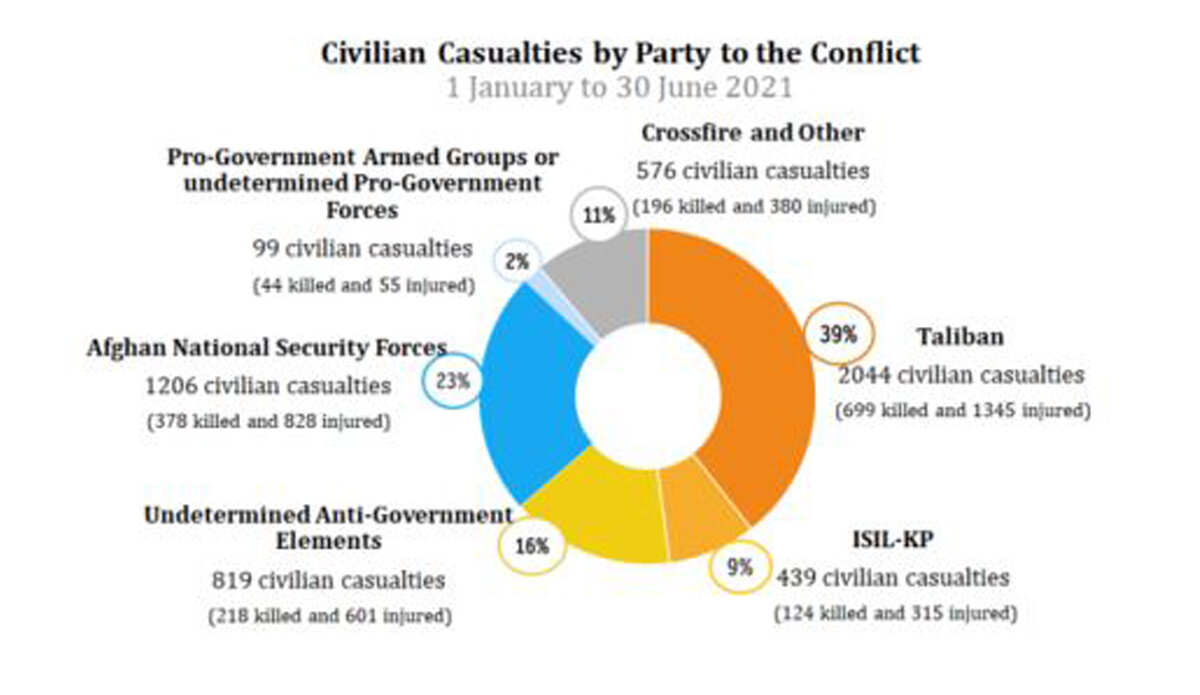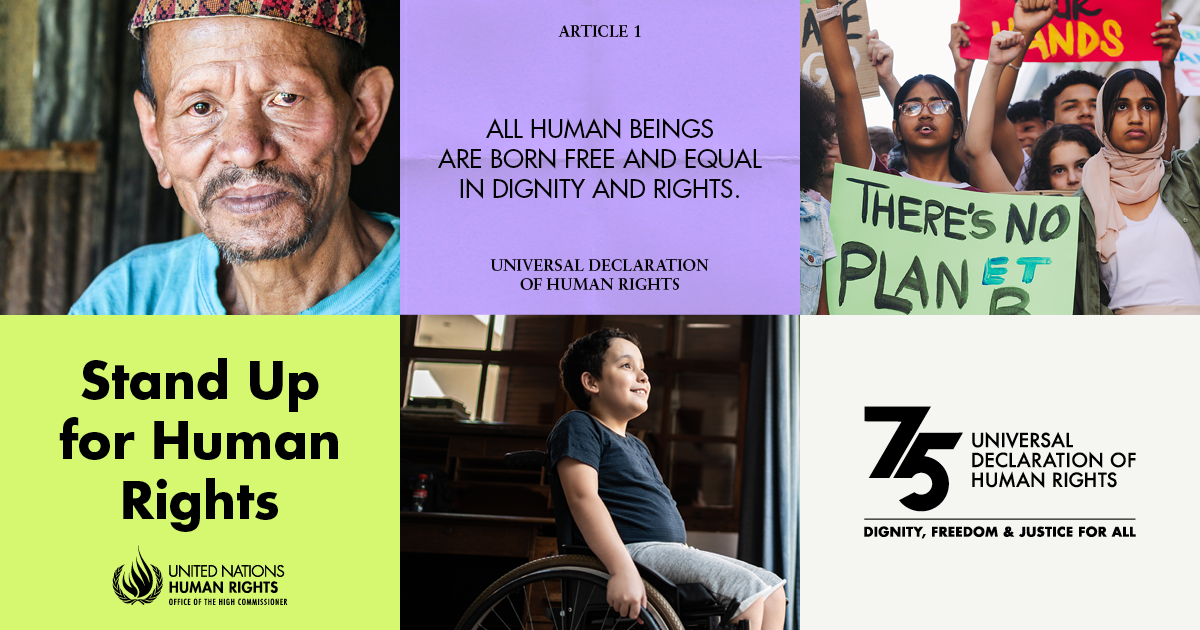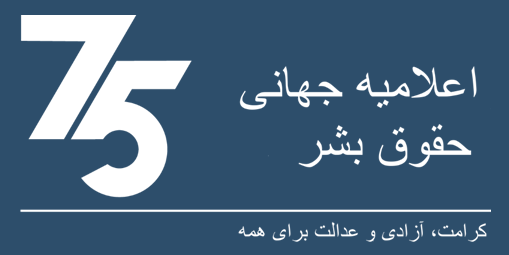Civilian casualties set to hit unprecedented highs in 2021 unless urgent action to stem violence – UN report
KABUL - Civilian casualties in Afghanistan in the first half of 2021 reached record levels, including a particularly sharp increase in killings and injuries since May when international military forces began their withdrawal and the fighting intensified following the Taliban’s offensive. In a new report issued today, the United Nations warns that without a significant de-escalation in violence Afghanistan is on course for 2021 to witness the highest ever number of documented civilian casualties in a single year since UNAMA records began.
UNAMA’s Afghanistan Protection of Civilians in Armed Conflict Midyear Update 2021 documents 5,183 civilian casualties (1,659 killed and 3,524 injured), a 47 per cent increase compared with the same period in 2020.
Of serious concern is the acute rise in the number of civilians killed and injured in the period from 1 May, with almost as many civilian casualties in the May-June period as recorded in the entire preceding four months. The number of civilian casualties during May and June – 2,392 in total (783 killed and 1,609 injured) – was the highest for those months since UNAMA began its systematic documentation in 2009. The period January-April 2021 saw 2,791 civilian casualties (876 killed and 1,915 injured).
“I implore the Taliban and Afghan leaders to take heed of the conflict's grim and chilling trajectory and its devastating impact on civilians. The report provides a clear warning that unprecedented numbers of Afghan civilians will perish and be maimed this year if the increasing violence is not stemmed," said Deborah Lyons, the Secretary-General’s Special Representative for Afghanistan.
The UN envoy, who is also the head of UNAMA called on the Taliban and Afghan leaders to, “Intensify your efforts at the negotiating table, stop the Afghan against Afghan fighting. Protect the Afghan people and give them hope for a better future.”
Much of the battlefield action during the most deadly months of May and June took place outside cities, in areas with comparatively low population levels. The UN is gravely concerned that if intensive military action is undertaken in urban areas with high population densities, the consequences for Afghan civilians could be catastrophic.
“The pursuit of a military solution will only increase the suffering of the Afghan people,” the report says.
The UN reminds the parties of their obligations under international law to protect civilians, and in particular highlights their stated commitment to do so, most recently expressed in the joint statement issued on 18 July 2021 by representatives of the Islamic Republic of Afghanistan and the Taliban in Doha, Qatar, when they agreed to prevent harm to civilians.
Particularly shocking and of deep concern is that women, boys and girls made up close to half of all civilian casualties in the first half of 2021. Comprising 46 per cent of all civilian casualties, 32 per cent were children – 1,682 in total (468 killed and 1,214 injured) and 14 per cent were women – 727 in total (219 killed and 508 injured). It is sickening to report that more women and more children were killed and injured than ever before recorded by UNAMA for the first half of any calendar year.
Anti-Government Elements (AGEs) were responsible for 64 per cent of the total civilian casualties: 39 per cent by Taliban, nearly nine per cent by Islamic State-Khorasan Province (ISIL-KP), and 16 per cent by undetermined AGEs.
Pro-Government Forces (PGFs) were responsible for 25 per cent of civilian casualties: 23 per cent by Afghan national security forces, and two per cent by pro-Government armed groups or undetermined PGFs.
UNAMA attributed 11 per cent of all civilian casualties to ‘crossfire’ during ground engagements where the exact party responsible could not be determined and other incident types, including unattributable unexploded ordnance/explosive remnants of war.
Civilian casualties attributed to AGEs increased by 63 per cent compared with the same period in 2020, while civilian casualties attributed to PGFs increased by 30 per cent.
It is noteworthy that this is the first report since UNAMA began its systematic civilian casualty documentation in 2009 that does not attribute a single civilian casualty to international military forces. The conflict has taken on a distinctly Afghan fighting Afghan character.
The leading causes of civilian casualties in the first half of 2021 were the extensive use of improvised explosive devices (IEDs) by AGEs, ground engagements between parties, targeted killings by AGEs, and air strikes by the Afghan Air Force.
The main cause of civilian casualties –the Taliban and ISIL-KP use of non-suicide IEDs – amounted to 38 per cent of all civilian casualties, nearly triple that recorded for the same period in 2020. The use of pressure-plate IEDs, nearly all by the Taliban, resulted in 42 per cent more civilian casualties than during the same period in 2020. Pressure-plate IEDs, which can be triggered even by a child stepping on them, may violate international humanitarian law and UNAMA reiterates its call on the Taliban to permanently ban the use of these indiscriminate devices.
Ground engagements caused 33 per cent of civilian casualties, with nearly all of these civilian casualties attributed to the Taliban and Afghan national security forces. Civilian casualties from ground engagements increased by 41 per cent compared with the first six months of 2020.
Targeted killings by AGEs were the third leading cause, responsible for 14 per cent of all civilian casualties. Airstrikes, attributable to the Afghan Air Force, accounted for eight per cent of civilian casualties. Compared with the first half of 2020, the total number of civilians killed and injured in airstrikes increased by 33 per cent.
UNAMA remains deeply concerned about the continuation of AGE attacks deliberately targeting civilians, particularly through the use of IEDs and shootings, including targeting of civilian government workers, human rights defenders, media workers, religious elders, and humanitarian workers, and sectarian-motivated attacks. Children were on at least one occasion deliberately targeted. The most shocking incident being the 8 May attack outside the Sayed ul-Shuhuda school in Kabul, which resulted in more than 300 civilian casualties, mostly school girls, including 85 killed, for which no AGE claimed responsibility.
UNAMA recorded a resurgence of deliberate sectarian-motivated attacks against the Shi’a Muslim religious minority, most of whom also belong to the Hazara ethnic minority, nearly all claimed by ISIL-KP. These included a string of non-suicide IED attacks and shootings, including at least eight IEDs in May-June alone that targeted buses or similar vehicles carrying members of the Hazara community. In total, between 1 January and 30 June 2021, UNAMA documented 20 incidents targeting Shi’a/Hazara, resulting in 500 civilian casualties (143 killed and 357 injured).
UNAMA is also concerned about the increasing number of reports of killing, ill-treatment, persecution and discrimination in communities affected by the current fighting and its aftermath. It is particularly important, especially during times of heightened conflict, that all parties respect the human rights and dignity of people and prevent such abuses and violations.
* * *
NOTE ON METHODOLOGY
For the purposes of its reports on the protection of civilians, UNAMA only includes verified civilian casualties. Civilian casualties are recorded as ‘verified’ where, based on the totality of the information reviewed by UNAMA, it has determined that there is ‘clear and convincing’ evidence that civilians have been killed or injured. In order to meet this standard, UNAMA requires at least three different and independent types of sources, i.e., victim, witness, medical practitioner, local authorities, confirmation by a party to the conflict, community leader or other sources.
Wherever possible, information is obtained from the primary accounts of victims and/or witnesses of the incident and through on-site fact-finding. Where UNAMA is not satisfied with the reliability and credibility of information concerning civilian casualties, it will not consider it as verified. Unverified incidents are not included in this report. UNAMA does not claim that the statistics presented in this report are complete and acknowledges possible under-reporting of civilian casualties given the limitations inherent in the operating environment, particularly considering the recent challenges posed by the COVID-19 pandemic and related measures.
Afghanistan Protection of Civilians in Armed Conflict Midyear Update 2021
http://unama.unmissions.org/protection-of-civilians-reports
 UN
UN
